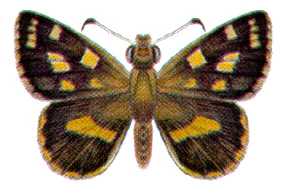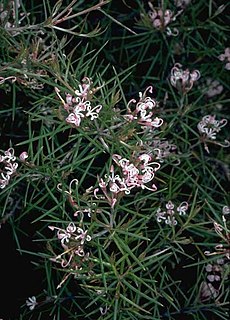
Gahnia is a genus of sedges native to China, Southeast Asia, New Guinea, Australia, New Zealand and a number of Pacific Islands. The common name is due to the toothed margins. It often forms tussocks.

Gahnia filum, the chaffy saw-sedge, is a tussock-forming perennial in the family Cyperaceae, endemic to Australia. It grows to between 60 and 110 cm in height.
Gahnia trifida, the coastal saw-sedge, is a tussock-forming perennial in the family Cyperaceae, endemic to southern Australia.

Antipodia chaostola, the chaostola skipper, is a butterfly of the family Hesperiidae. It is found in Australia along the coast of Victoria, New South Wales and Tasmania.

Hesperilla chrysotricha, the chrysotricha skipper or goldenhaired sedge-skipper, is a butterfly of the family Hesperiidae. It is found in the Australian states of Victoria, Tasmania, South Australia and Western Australia.

Hesperilla crypsargyra, the silvered skipper or silver hedge-skipper, is a butterfly of the family Hesperiidae. It is found in the Australian states of New South Wales, Queensland and Victoria.

Hesperilla donnysa, the donnysa skipper or varied sedge skipper, is a butterfly of the family Hesperiidae. It is found in the Australian Capital Territory, New South Wales, Queensland, South Australia, Tasmania, Victoria and Western Australia.

Hesperilla idothea, the flame sedge-skipper, is a butterfly of the family Hesperiidae. It is found in the Australian states of New South Wales, Queensland, South Australia and Victoria.

Hesperilla ornata, the spotted skipper or spotted sedge-skipper, is a butterfly of the family Hesperiidae. It is found along the non-tropical eastern seaboard of mainland Australia and in the adjacent mountain ranges.

Gahnia sieberiana, commonly known as the red-fruit saw-sedge, is a tussock-forming perennial plant in the family Cyperaceae, endemic to Australia. It is a widespread plant that favours damp sunny sites. Many insect larvae have been recorded feeding on the red-fruit saw-sedge. It may grow over 2 metres tall.
Gahnia radula, commonly known as the thatch saw-sedge is a tufted perennial sedge native to south-eastern Australia. The leaves are long, flat and rough, with sharp edges. It has a distinctive brown inflorescence, which darkens to black. It grows to 50–100 cm in height, spreads through its rhizomes and is found in eucalypt forest and grassy woodland.

Gahnia erythrocarpa is a leafy sedge, growing up to 2 metres tall. Found in damp areas in forest or woodland in the Sydney district of Australia. This is one of the many plants first published by Robert Brown with the type known as "(J.) v.v." appearing in his Prodromus Florae Novae Hollandiae et Insulae Van Diemen in 1810. The specific epithet erythrocarpa is from ancient Greek and refers to the red seeds.
Russell Lindsay Barrett is an Australian botanist.

Grevillea halmaturina is a species of flowering plant in the family Proteaceae and is endemic to South Australia. It is a prickly, spreading to erect shrub with sharply-pointed, linear to more or less-cylindrical leaves and large groups of white to pale pink flowers.
Gahnia ancistrophylla, also known as hooked-leaf saw sedge, is a tussock-forming perennial in the family Cyperaceae, that is native to southern parts of Western Australia, South Australia and Victoria.

Gahnia australis is a tussock-forming perennial in the family Cyperaceae, that is native to southern western parts of Western Australia.

Gahnia decomposita is a tussock-forming perennial in the family Cyperaceae, that is native to southern parts of Western Australia.
Gahnia drummondii is a tussock-forming perennial in the family Cyperaceae, that is native to south western parts of Western Australia.
Gahnia sclerioides is a tussock-forming perennial in the family Cyperaceae, that is native to south western parts of Western Australia.
Gahnia deusta is a tussock-forming perennial in the family Cyperaceae, that is native to southern parts of Australia.












